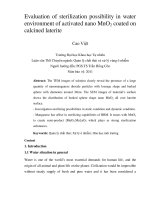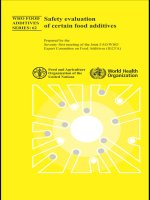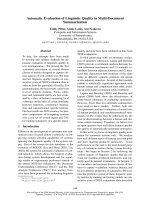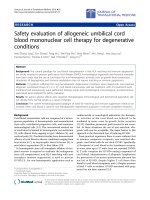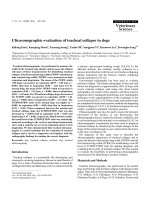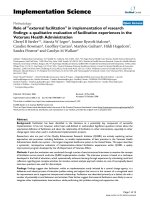Safety evaluation of mulberry powder assessment of subchronic toxicity in rats
Bạn đang xem bản rút gọn của tài liệu. Xem và tải ngay bản đầy đủ của tài liệu tại đây (945.06 KB, 9 trang )
JOURAL OF MEDICAL RESEARCH
SAFETY EVALUATION OF MULBERRY POWDER:
ASSESSMENT OF SUBCHRONIC TOXICITY IN RATS
Pham Thi Van Anh1, Vu Viet Hang1, Dao Thi Ngoan1
Ta Minh Nguyet2, and Dinh Thi Thu Hang1,*
Hanoi Medical Unversity
Ngoc Thien Trading and Pharamaceutical Joint Stock Company
1
2
Obesity has reached epidemic proportions globally, with at least 2.8 million people dying each year due
to being overweight or obese. Because of the botamical's chemical diversity and the ability to act on various
biological targets, plant products have long been a thriving source for discovering new compounds to treat
obesity. MULBERRY powder was a herbal-derived product combined with Amorphophallus konjac K. Koch starch
and mulberry (Morus alba L.) leaves extract; these plants have long been used in Asia as food sources and as
traditional medicines. So far, the safety of this product has not been reported yet in the world and Vietnam. Thus,
this study was designed to assess the subchronic toxicity of MULBERRY powder in Wistar rats. The method used
in this study followed the guidance of the World Health Organization and Organization for Economic Co-operation
and Development in rats with two oral doses of 1.2 g/kg b.w/day and 3.6 g/kg b.w/day for 12 consecutive weeks.
As a result, MULBERRY powder at both doses caused no significant changes in body weight, hematological
indexes, functions, and microscopic images of livers and kidneys, although MULBERRY powder at 3.6 g/kg
b.w/day caused diarrhea at about 20% of rats. In conclusion, MULBERRY powder did not cause subchronic
toxicity in experimental rats. However, this partly revealed the safety of MULBERRY powder in clinical practice.
Keywords: MULBERRY powder, Amorphophallus konjac K. Koch, Morus alba L., subchronic toxicity, rats.
I. INTRODUCTION
Obesity is a worldwide epidemic characterized
by excess adipose tissue and contributes to
numerous chronic diseases and early mortality.
This epidemic has received both national and
international attention because of obesity’s
detrimental impact on health, the enormous
economic burden it imposes, and its increasing
prevalence. The adverse health consequences
associated with obesity include cardiovascular
disease, stroke, type 2 diabetes mellitus,
hypertension, dyslipidemia, cancers of the breast,
endometrium, prostate, colon cancer, gallbladder
Corresponding author: Dinh Thi Thu Hang
Hanoi Medical University
Email:
Received: 11/11/2021
Accepted: 21/12/2021
JMR 154 E10 (6) - 2022
disease, osteoarthritis, respiratory problems,
asthma and sleep apnea and perhaps depression.1
According to WHO, obesity has reached epidemic
proportions worldwide, with approximately 1.9
billion overweight and 650 million obese adults.2
NICE currently recommends pharmacological
treatment for weight loss maintenance in addition
to a reduced-calorie diet and optimal physical
exercise, such as orlistat, liraglutide, naltrexone/
bupropion. However, these synthetic drugs
caused undesirable effects such as nausea,
headaches, and constipation.3 Therefore, one
of the most urgent research missions was the
discovery of novel drugs derived from herbs which
not only exhibited anti-obesity effect but also
limited side effects. Toxicity refers to unwanted
effects on biological systems. In order to evaluate
biological toxicity, it is imperative to choose the
1
JOURAL OF MEDICAL RESEARCH
correct system since no effects may otherwise be
seen. Toxicity of a substance can be impacted by
many factors, such as the route of exposure (skin
absorption, ingestion, inhalation, or injection);
the time of exposure (a brief, acute, subchronic,
or chronic exposure); the number of exposures
(a single dose or multiple doses over time ); the
physical form of the toxin (solid, liquid, or gas); the
organ system involved (cardiovascular, nephro-,
hemo-, nervous-, or hematopoietic-system); and
even the genetic makeup and robustness of the
target cells or organisms.4 Subchronic systemic
toxicity is defined as adverse effects occurring
after a test sample’s was administered repeatly or
continuously for up to 90 days or not exceeding
10% of the animal’s lifespan.5
Amorphophallus konjac K. Koch and mulberry
(Morus alba L.) were the main components
of MULBERRY powder. These plants have
long been used in Asia as food sources and
as traditional medicines. Glucomannan (GM),
a soluble fiber derived from Amorphophallus
konjac, is marketed for weight loss.6 The
leaves, roots, and branches of Morus species
are used to treat fevers, hepatic protection,
vision improvement, strengthen joints, reduce
blood pressure, and control blood glucose
levels.7 However, there have been no report
available on the toxicity of the combination of
these components in the world and Vietnam so
far. Therefore, in this study, we aimed to assess
the subchronic toxicity of MULBERRY powder
in experimental animals.
II. METHODS
1. The preparation of MULBERRY powder
MULBERRY was manufactured by Ngoc
Thien Trading and Pharmaceutical Joint Stock
Company. This product was prepared and
offered in the form of sachets. Each sachet
contained 3.860 mg Amorphophallus konjac
2
K. Koch starch, and 1.140 mg mulberry (Morus
alba L.) leaves extract. The recommended
dosage in patients was two sachets per day.
MULBERRY powder was prepared daily by
dissolving with distilled water before giving to
rats. Rats were orally administered this mixture
immediately after dissolving, the remaining
product was removed.
2. Chemicals and laboratory equipments
Kits for testing enzymes and metabolites
in blood: ALT (alanin aminotransferase), AST
(aspartat aminotransferase), total bilirubin,
albumin, total cholesterol, creatinine kits from
Hospitex Diagnostics (Italy) và and DIALAB
GmbH (Austria) were used for Screen Master
machine of Hospitex Diagnostics (Italy).
Blood-testing solutions ABX Minidil LMG of
ABX Diagnostics were used for Vet abcTM
Animal Blood Counter. Chemicals for tests and
histopathological examination.
3. Experimental animals
Healthy Wistar rats (180 ± 20 g) were used
in this study. The animals were housed in cages
(groups of ten rats/cage) under the standard
conditions (temperature 250C ± 20C and relative
humidity 80% ± 10%), 12 hours dark/light time.
We fed the rats with standard animal feed
and allowed free access to water. They were
acclimated to housing for at least one week prior
to the study at the Department of Pharmacology,
Hanoi Medical University.
4. Subchronic toxicity study
Subchronic toxicity studies were carried
out according to WHO Guidance and OECD
guidelines.8,9
The study was carried out in a continuous
12-week period. Wistar rats were divided into
three groups of ten animals:
- Group 1 (control) was the distilled water
control group. Each rat was given 1 ml distilled
JMR 154 E10 (6) - 2022
JOURAL OF MEDICAL RESEARCH
water/100 g b.w/day orally.
- Group 2 was given orally MULBERRY
powder at the dose of 1.2 g/kg b.w/day
(equivalent to the human recommended dose,
conversion ratio 6);
- Group 3 was given orally MULBERRY
powder at the dose of 3.6 g/kg b.w/day (3 times
as high as the dose at group 2).
complete gross necropsy at the end of the
experiment. Liver and kidney were removed for
histopathology examinations in 30% pf rats in
each group. The micro-histological examination
was carried out at the Center for Research and
Early Detection of Cancer (CREDCA). Assoc.
Prof. Le Dinh Roanh, Director of CREDCA, gave
results of pathological image analysis.
Animals were treated once daily in the
morning for 12 consecutive weeks, and
observed once daily to detect signs of toxicity.
5. Statistical analysis
The signs and indexes checked during the
study are:
between the experimental groups and the control
group were made using the student’s t-test. Data
are shown as mean ± standard deviation. All data
were considered significant at p < 0.05.
- General condition consisting of mortality
and clinical signs.
- Body weight changes.
- Hematopoietic function test: red blood cells
(RBC), hemoglobin (HGB), hematocrit, total
white blood cells (WBC), WBC differentials,
platelet count (PLT).
- Serum biochemistry: aspartate aminotransferase (AST), alanine aminotransferase
(ALT), total bilirubin, albumin, total cholesterol,
and creatinine levels.
The parameters were checked before
treatment, four weeks after treatment, eight
weeks after treatment, and twelve weeks after
treatment. All animals were subjected to a
Data were analyzed using Microsoft Excel
software version 2010. The levels of significance
III. RESULTS
1. General condition
None of the animals showed any macroscopic
or gross pathological changes compared with
the control group. In general, animals in groups 1
and 2 had normal locomotor activities and good
feedings. However, in group 3, after one week
of oral administration of MULBERRY powder at
the dose of 3.6 g/kg b.w/day, about 20% of rats
had diarrhea, loose stool, and wet anus. This
condition was reduced and resolved entirely for
two weeks after stopping the treatment.
2. Body weight changes
Table 1. The effect of MULBERRY powder on body weight
Body weight (g)
Time
Group 1
Group 2
Group 3
196.0 ± 50.4
197.0 ± 35.0
203.0 ± 41.4
4
239.0 ± 58.6
240.0 ± 38.6∆
230.0 ± 45.9
8
262.0 ± 48.9∆∆
258.0 ± 35.8∆∆
230.0 ± 50.3
12
265.0 ± 50.2∆∆
255.0 ± 36.0∆∆
238.0 ± 45.4
Before treatment
After treatment (weeks)
Δ
p < 0.05,
ΔΔ
p < 0.01, ΔΔΔ p < 0.001 compared with the time point “Before treatment”
* p < 0.05, ** p < 0.01, *** p < 0.001 compared with Group 1
JMR 154 E10 (6) - 2022
3
JOURAL OF MEDICAL RESEARCH
Table 1 showed that after four weeks, eight
weeks, and twelve weeks of treatment, body
weight of rats in groups 1 and 2 increased
substantially compared with body weight “Before
treatment”. In group 3, there was no statistical
change in the body weight of rats as compared
with the time point “Before treatment”. No
significant differences were observed between
groups treated with MULBERRY powder and
the control group (group 1) (p > 0.05).
3. Effect on hematological examination
Table 2. Effect of MULBERRY powder on hematopoietic function
Parameters
Red blood cells
count (T/L)
Hemoglobin level
(g/dL)
Hematocrit
(%)
MCV
(fL)
Platelet count
(G/L)
Group
Before treatment
Group 1
After treatment (weeks)
4
8
12
10.58 ± 1.19
9.56 ± 1.11
9.89 ± 1.02
10.34 ± 1.12
Group 2
9.24 ± 1.86
10.42 ± 0.75
10.08 ± 0.93
9.84 ± 0.80
Group 3
9.32 ± 1.69
9.90 ± 1.35
10.34 ± 0.94
10.48 ± 0.53
Group 1
14.58 ± 1.56
12.73 ± 2.38
13.20 ± 1.44
13.28 ± 1.24
Group 2
13.58 ± 1.14
13.97 ± 1.31
13.02 ± 1.13
12.98 ± 0.87
Group 3
13.79 ± 1.32
13.50 ± 1.78
13.54 ± 1.19
13.41 ± 0.81
Group 1
58.77 ± 7.09
51.93 ± 7.73
52.10 ± 7.54
53.55 ± 6.18
Group 2
53.93 ± 3.05
56.05 ± 4.63
50.76 ± 4.43
50.65 ± 4.73
Group 3
54.79 ± 5.11
52.63 ± 7.55
52.74 ± 4.88
53.36 ± 4.88
Group 1
55.50 ± 1.58
52.10 ± 5.15
51.60 ± 5.80
52.50 ± 4.28
Group 2
53.60 ± 2.55
53.00 ± 2.71
51.00 ± 3.33
51.10 ± 3.28
Group 3
53.90 ± 2.92
53.10 ± 1.37
51.80 ± 2.39
52.00 ± 2.26
Group 1
475.9 ± 136.6
592.7 ± 147.8 603.0 ± 158.6 627.8 ± 184.1
Group 2
524.9 ± 73.3
614.9 ± 130.5 616.8 ± 120.0 598.1 ± 247.4
Group 3
575.5 ± 80.0
686.0 ± 145.9 669.6 ± 129.7 545.3 ± 156.7
MCV: Mean corpuscular volume
Δ
p < 0.05,
ΔΔ
p < 0.01, ΔΔΔ p < 0.001 compared with the time point “Before treatment”
* p < 0.05, ** p < 0.01, *** p < 0.001 compared with Group 1
There was no significant difference in red
blood cells count, hematocrit, hemoglobin
level, MCV and platelet count between groups
4
treated MULBERRY powder and group 1 (p >
0.05) (Table 2).
JMR 154 E10 (6) - 2022
JOURAL OF MEDICAL RESEARCH
Table 3. Effects of MULBERRY powder on total WBC count and WBC differentials
Parameters
Total WBC count
(G/L)
Lymphocytes
(G/L)
Neutrophils
(G/L)
Group
Before treatment
Group 1
After treatment (weeks)
4
8
12
10.64 ± 3.55
9.54 ± 3.86
10.47 ± 2.39
11.61 ± 3.36
Group 2
8.53 ± 1.94
9.97 ± 1.89
11.36 ± 3.87
10.68 ± 3.41
Group 3
9.92 ± 2.92
12.06 ± 2.74
10.59 ± 3.10
10.83 ± 1.75
Group 1
7.6 ± 2.8
6.6 ± 2.8
7.4 ± 1.8
8.5 ± 2.7
Group 2
6.1 ± 1.6
6.7 ± 1.2
7.0 ± 1.6
7.2 ± 2.7
Group 3
6.8 ± 1.8
8.6 ± 1.7
7.5 ± 2.8
7.2 ± 1.8
Group 1
1.6 ± 0.4
1.4 ± 0.6
1.8 ± 0.9
1.4 ± 0.2
Group 2
1.4 ± 0.5
1.7 ± 0.6
1.8 ± 1.0
2.3 ± 1.6
Group 3
1.6 ± 0.5
1.7 ± 0.8
1.6 ± 0.5
1.8 ± 0.8
WBC: white blood cells
Δ
p < 0.05, ΔΔ p < 0.01, ΔΔΔ p < 0.001 compared with the time point “Before treatment”
* p < 0.05, ** p < 0.01, *** p < 0.001 compared with Group 1
Table 3 demonstrated that at all time points,
there was no significant difference in total WBC
count, lymphocytes, and neutrophils at groups
treated MULBERRY powder compared with
group 1 and the time point “before treatment”
(p > 0.05).
4. Effect on liver parameters
There were no significant differences in
aspartate aminotransferase (AST) level, and
alanine aminotransferase (ALT) level, total
bilirubin, albumin concentration, and total
cholesterol concentration between groups
treated MULBERRY powder and group 1 (p >
0.05). The results are shown in Table 4.
Table 4. Effects of MULBERRY powder on liver parameters.
Parameters
AST level (UI/L)
ALT level (UI/L)
Group
Before treatment
Group 1
After treatment (weeks)
4
8
12
79.4 ± 17.0
78.6 ± 18.6
79.2 ± 28.8
76.7 ± 12.9
Group 2
95.6 ± 24.8
101.4 ± 30.6
93.6 ± 26.8
77.7 ± 15.6
Group 3
97.2 ± 24.0
101.0 ± 30.1
91.6 ± 28.1
89.2 ± 18.0
Group 1
46.5 ± 9.6
36.7 ± 12.4
36.0 ± 13.5
37.1 ± 10.5
Group 2
43.7 ± 7.9
47.3 ± 19.8
37.2 ± 11.1
36.7 ± 10.6
Group 3
47.6 ± 10.7
38.2 ± 10.6
40.8 ± 9.7
38.9 ± 8.9
JMR 154 E10 (6) - 2022
5
JOURAL OF MEDICAL RESEARCH
Parameters
Group
Before treatment
Group 1
After treatment (weeks)
4
8
12
13.33 ± 0.55
13.44 ± 0.37
13.45 ± 0.48
13.44 ± 0.29
Group 2
13.01 ± 0.76
13.46 ± 0.23
13.53 ± 0.39
13.38 ± 0.63
Group 3
13.16 ± 0.76
13.62 ± 0.26
13.69 ± 0.48
13.55 ± 0.54
Albumin
concentration (g/
dL)
Group 1
3.22 ± 0.31
3.10 ± 0.23
3.27 ± 0.34
3.14 ± 0.48
Group 2
3.28 ± 0.39
3.31 ± 0.34
3.12 ± 0.22
3.16 ± 0.25
Group 3
3.19 ± 0.41
3.32 ± 0.36
3.23 ± 0.42
3.34 ± 0.33
Total cholesterol
concentration
(mmol/L)
Group 1
1.25 ± 0.25
1.22 ± 0.19
1.12 ± 0.13
1.24 ± 0.25
Group 2
1.42 ± 0.25
1.38 ± 0.22
1.20 ± 0.23
1.23 ± 0.14
Group 3
1.42 ± 0.27
1.40 ± 0.22
1.34 ± 0.18
1.34 ± 0.18
Total bilirubin
(mmol/L)
Δ
p < 0.05,
ΔΔ
p < 0.01, ΔΔΔ p < 0.001 compared with the time point “Before treatment”.
* p < 0.05, ** p < 0.01, *** p < 0.001 compared with Group 1.
5. Effect on kidney function
Table 5 illustrated that MULBERRY powder
caused no significant differences in serum
creatinine level between groups treated
MULBERRY powder and group 1 (p > 0.05).
Table 5. Effects of MULBERRY powder on serum creatinine level
Creatinine level (mg/dl)
Days
Group 1
Group 2
Group 3
0.86 ± 0.20
0.88 ± 0.09
0.87 ± 0.14
4
0.78 ± 0.11
0.78 ± 0.15
0.79 ± 0.14
8
0.79 ± 0.17
0.76 ± 0.16
0.84 ± 0.17
12
0.85 ± 0.14
0.80 ± 0.14
0.90 ± 0.19
Before treatment
After treatment
(weeks)
Δ
p < 0.05,
ΔΔ
p < 0.01, ΔΔΔ p < 0.001 compared with the time point “Before treatment”
* p < 0.05, ** p < 0.01, *** p < 0.001 compared with Group 1
6. Histopathological examination
No gross lesions or changes in size were
examined in the hearts, livers, lungs, kidneys,
and abdominal cavities when all experimental
rats were subjected to a complete gross
necropsy.
6
There was no significant difference in
histopathological examination of livers and
kidneys between groups treated MULBERRY
powder and the control group after 12 weeks of
treatment (Figures 1 and 2).
JMR 154 E10 (6) - 2022
JOURAL OF MEDICAL RESEARCH
Group 1
Group 2
Group 3
Figure 1. Histopathological images of livers (HE × 400)
Group 1
Group 2
Group 3
Figure 2. Histopathological images of kidneys (HE × 400)
IV. DISCUSSION
Subchronic toxicity of MULBERRY powder
Toxicity is the degree to which a substance
can harm humans or animals. Toxicity can
refer to the effect on a cell (cytotoxicity),
an organ (e.g., renal or liver toxicity), or the
whole organism. In order to determine the
safety of drugs and plant products for human
use, toxicological evaluation is carried out
in various experimental animal models to
predict the toxicity and provide guidelines
for selecting ‘safe’ therapeutic doses in
humans. A subchronic toxicity study provides
information on the effects of repeated oral
exposure and can indicate the need for further
longer-term studies.8,11 Subchronic studies
assess the undesirable effects of continuous
JMR 154 E10 (6) - 2022
or repeated exposure of plant extracts or
compounds over a portion of the average
life span of experimental animals, such as
rodents. Specifically, they provide information
on target organ toxicity.12
In general, during the experiment, rats in
groups 1 and 2 showed normal conditions
(normal locomotor activities and good
feedings). However, in group 3, about 20% of
rats administrated MULBERRY powder at the
dose of 3.6 g/kg b.w/day had diarrhea, loose
stool, and wet anus. No significant change was
observed in all hematological and biochemical
parameters and histopathological results.
The body weight changes serve as a
sensitive indicator of the general health status of
7
JOURAL OF MEDICAL RESEARCH
animals.12 Weights were observed in all animals
treated with MULBERRY powder. However,
body weight gain at the dose of 3.6 g/kg b.w/
day decreased compared with groups 1 and
2, but no significant difference was observed
compared with the control group (group 1). It
can be concluded that MULBERRY powder
did not interfere with the normal metabolism of
animals, as corroborated by the nonsignificant
difference from animals in the control group.
The hematopoietic system is one of the
most sensitive targets of toxic compounds
and is an essential index of physiological and
pathological status in men and animals.8,11 After
four weeks, eight weeks, and twelve weeks
of the treatment, there were no significant
differences in total red blood cells, hematocrit,
hemoglobin level, platelet count, total WBC
count, and WBC differentials between groups
treated MULBERRY powder and control group.
It could be concluded that the administration
of MULBERRY powder did not affect the
hematological profile and blood formation
products. Furthermore, such analysis is
relevant to risk evaluation as changes in the
hematological system have higher predictive
value for human toxicity when the data are
translated from animal studies.
Analysis of kidney and liver function is
critical in the toxicity evaluation of drugs and
plant extracts as they are both necessary
for the survival of an organism. The clinical
biochemistry analyses were carried out to
evaluate the plant products’ possible alterations
in hepatic and renal functions.13 The liver
releases AST, ALT, and an elevation in plasma
concentration indicates liver damage.8 There
was no substantial change in AST level and ALT
level between the group treated MULBERRY
powder and the control group. These results
indicated that MULBERRY powder had no
8
deleterious effect on liver function.
Creatinine levels can be used in describing
the function of the kidneys.11 No significant
difference was observed in blood biochemical
parameters between the control group and
groups treated MULBERRY powder at various
dose levels (p > 0.05). Thus, MULBERRY
powder did not affect liver and kidney function.
The histopathological examination revealed
the alteration in cell structure when viewed
under the light microscope. The further
histological study could furnish more information
regarding the hepatotoxicity and nephrotoxicity
of MULBERRY powder. Our study showed
no significant difference in histopathological
examination of the liver and kidney between
groups treated with MULBERRY powder and
the control group.
Overall, the findings of this study indicated
that no significant differences were observed
in blood profile, biochemistry parameters, and
histopathological observations of liver and
kidney tissues between groups treated with
MULBERRY powder and the control group.
Previous reports about the toxicity of
Amorphophallus konjac K. Koch and Morus
alba L. were still limited globally. A few clinical
trials proved the safety of glucomannan (a
soluble fiber derived from Amorphophallus
konjac) in adults.14 According to the study of
Atiya sabsung, the oral administration of Morus
alba L. leaf extract at doses 1.2 g/kg/day and
3.0 g/kg/day for 60 days did not significantly
affect blood chemistry, hematologic values,
and microscopic examination of Wistar rats.15
Another report about the safety of Morus alba
L. showed that no treatment-related mortality
or adverse effects were observed at group
treated M alba leaves extract at the highest
dose of 4.000 mg/kg bw/d for both male and
female rats.16
JMR 154 E10 (6) - 2022
JOURAL OF MEDICAL RESEARCH
V. CONCLUSION
MULBERRY powder doses of 1.2 g/kg b.w/
day and 3.6 g/kg b.w/day administered orally
for 12 weeks did not cause toxic signs or
evident symptoms of subchronic toxicity rats.
About 20% of rats administrated MULBERRY
powder at the dose of 3.6 g/kg b.w/day had
diarrhea. However, no significant change was
observed in all hematological and biochemical
parameters and histopathological results.
REFERENCES
1. Susan B Racette, Susan S Deusinger
and Robert H Deusinger. Obesity: Overview of
Prevalence, Etiology, and Treatment. Physical
Therapy. 2003; 83(3): 276-288.
2. World Health Organization Obesity and
overweight. Geneva: WHO, 2017.
3. Ruban A, Stoenchev K, Ashrafian H, et al.
Current treatments for obesity. Clin Med (Lond).
2019 May; 19(3): 205-212.
4. Venkatasubbu GD, Ramasamy S,
Gaddam PR, et al. Acute and subchronic
toxicity analysis of surface modified paclitaxel
attached hydroxyapatite and titanium dioxide
nanoparticles.
International
Journal
of
Nanomedicine. 2015; 10:137-148.
5. De Jong WH, Carraway JW, Geertsma
RE. In vivo and in vitro testing for the biological
safety evaluation of biomaterials and medical
devices. Biocompatibility and Performance of
Medical Devices. 2012; 120-158.
6. Chua M, Baldwin TC, Hocking TJ, et al.
Traditional uses and potential health benefits
of Amorphophallus konjac K. Koch ex N.E.Br. J
Ethnopharmacol. 2010 Mar 24; 128(2): 268-78.
7. de Oliveira AM, Mesquita Mda S, da
Silva GC, et al. Evaluation of Toxicity and
Antimicrobial Activity of an Ethanolic Extract
from Leaves of Morus alba L. (Moraceae). Evid
JMR 154 E10 (6) - 2022
Based Complement Alternat Med. 2015; 2015:
513978.
8. OECD, Guidelines for the testing of
chemicals repeated dose oral toxicity study
in rodents, Environmental Health and Safety
Monograph Series on Testing and Assesment
No 407. 2008.
9. World Health Organization. Guidelines
for Assessing Quality of Herbal Medicines With
Reference to Contaminants and Residues,
Geneva. 2007.
10. Litchfield J T& Wilcoxon F A. A simplified
method of evaluating dose-effect experiments.
J. Pharmacol. Exp. Ther. 1949; 96: 99-113.
11. World Health Organization. Working
group on the safety and efficacy of herbal
medicine. Report of regional office for
the western pacific of the World Health
Organization. 2000.
12. National Research Council. Toxicity
testing for assessing environmental agents.
Interim Report. Washington, DC, USA: National
Academies Press. 2006.
13. Olson H, Betton G, Robinson D et al.
Concordance of the toxicity of pharmaceuticals
in humans and in animals. Regulatory Toxicology
and Pharmacology. 2000; 32(1):56–67.
14. Keithley JK, Swanson B, Mikolaitis
SL et al. Safety and efficacy of glucomannan
for weight loss in overweight and moderately
obese adults. J Obes. 2013; 2013: 610908.
15. Atiya sabsung, Srichan Phornchirasilp,
Omboon Luanratana et al (2004). A Toxicity
Study of Morus Alba L. Leaf Extract. Thai
Journal of Pharmacology. 2004; 26(1).
16. Tennille K. Marx, Róbert Glávits, John
R. Endres et al. A 28-Day Repeated Dose
Toxicological Study of an Aqueous Extract
of Morus Alba L. International Journal of
Toxicology; 35(6): 683-691.
9
